Introduction: Edison’s electric pen, developed in 1875 and patented in 1876, made low-cost copying available to anyone with $30 to spend. The first mass-produced electric-motor-powered appliance ever offered for sale, the pen was an immediate success, but was superseded by improved methods after just a few years.
With the generous help of the editors of the Thomas A. Edison Papers, together with that of historians and curators at the Thomas Edison National Historical Park (West Orange, New Jersey); The Henry Ford museum (Dearborn, Michigan); the Edison & Ford Winter Estates museum (Fort Myers, Florida); the National Museum of American History (Smithsonian Institution, Washington DC); the SPARK Museum of Electrical Invention (Bellingham, Washington); museums worldwide with Edison material; and individual collectors and researchers, I have assembled here the story of the design, production, and marketing of Edison’s electric pen and duplicating press.
Most of the research for this page was made possible by the Thomas A. Edison Papers project. Begun in 1978, the project is an ongoing many-decades work by countless editors and scholars, making available the most significant of the approximately five million documents created by Edison, his staff, and their correspondents throughout Edison’s working life. The papers are preserved at Rutgers University in New Jersey, and are being published chronologically in book, microfilm, and digital form.
All quoted material is from documents available on line at the Edison Papers website, and each original document referenced in the text may be viewed by clicking on its [Document ID] link. These links will open in a new window; closing that window will return you to this page.
The Thomas A. Edison Papers Digital Edition, as the online archive is now called, is much more accessible than it was when I began this research in 2011, and all material tagged as “Electric pen and mimeograph” may be viewed in date order at this link (1272 items as of May 2023).
Further information on the electric pen may be found on the main page for this site.
|
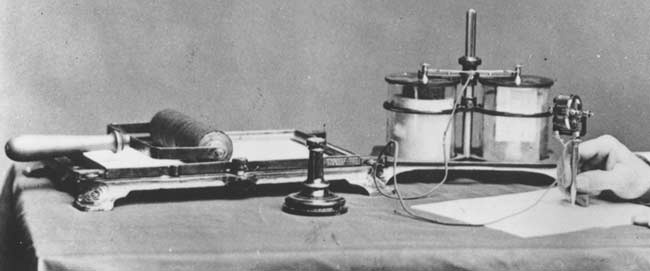
The complete outfit: Ink roller and duplicating press, pen holder, battery, pen, and stencil |
Editor’s Note: Throughout this site, each document identifier enclosed by [brackets] is a direct link to the original document at the Thomas A. Edison Papers website.
Electric Pen Invention and Development
Paul Israel’s definitive 1998 biography, Edison: A Life of Invention, notes that in June 1875 Edison returned to full-time invention, a major turning point in his life. Having set up a laboratory and machine shop in Newark in 1871, Edison had continued to work for other companies. Now, determined to become independent of corporate sponsors, on a document titled “Wanted May 31 1875,” Edison and his “chief experimental assistant” Charles Batchelor drew up a list of ideas which might be developed to support the shop. [NS7501A]
Idea number 18 on that list was “a copying press & system that will take 100 copies,” and number 19, the final entry, was “A cheap process of printing new”.
These were the ideas which became “Edison’s Electric Pen & Duplicating Press” later that year.
Document duplicating technology at the time was quite limited in its capabilities. A practical typewriter was just being developed; carbon paper was not suitable for use with quill and other ink pens; and the letter copying press could make only one or two copies from documents written with a special ink. For multiple copies the only options were letterpress or lithographic printing, both of which required skilled workers and expensive equipment, restricting their use to commercial printers and large companies with in-house print shops. For small businesses, sales agents, legal offices, churches, and others requiring a low-cost, moderate volume copying device, there was no easy process.
In the middle of the 1870s, things began to change. On 15 September 1874 a British patent was issued to Eugenio de Zuccato, an Italian living in London, for a duplicating process which he called the Papyrograph. This process used a sheet of lacquer-coated paper, on which the user would write with corrosive ink. The corrosive etched away the varnish; the stencil was then washed with water which rendered the etched area porous to printing ink, while the rest of the stencil remained impervious. Copies were made by placing the stencil on a modified letter copy press using a somewhat cumbersome process.
While the word “stencil” used as a verb is cited by the Oxford English Dictionary as long ago as 1420, and as a noun in 1707, Zuccato’s patent was the first use of the word in reference to copying handwriting. The stencil was the key element in office copying systems from 1875 until (and for many years after) the introduction of the photocopier in the early 1950s. Developing a simple method of making a stencil that anyone could use was the key to Edison’s success with the electric pen and duplicating press system.
On the same day as Edison and Batchelor created their list of ideas, 31 May 1875, they made an entry in the Newark Shop Notebooks recording the first work on the Autographic Copying Press. This was conceived as a chemical transfer method, a refinement of the existing letter copy press technology. The notebook has samples of the copies they made to accompany the description of the process:
The samples shown on the opposite page are the result of the first experiment tried in the new Laboratory, and for want of a better name it will be called the Autographic Copying Press.
Tissue paper written upon by an ink composed of aniline violet and proto chloride of iron saturated solution. The paper which receives the copy is saturated with the ferric cyanide of potassium. [NE1676229]
A further entry on 11 June describes more experiments on ink [NE1676237], but the breakthrough is recorded on 30 June 1875:
We struck the idea of making a stencil of the paper by pricking with a pen & then rubbing over with an ink.
The best ink we found to be glycerine & aniline violet. Cut a piece of steel 2 x 3 like a file but with points straight up & tried to perforate the paper by writing on this with a stylus it works but it takes such pressure to do it at all, that it is not much good.
Resolved to make a machine to go by clockwork or engine & prick as we write, in the mean time we took numerous copies with the letters pricked by hand. [NE1676239]
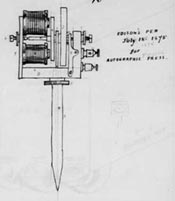
Edison’s pen design
18 July 1875
[MBN001003] |

Sketch in Batchelor’s
notes of 20 July 1875
[NE1676255] |

Details x and †
[NE1676255] |
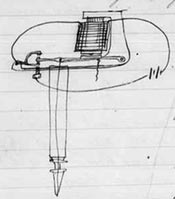
Sketch of proposed
direct acting pen
20 July 1875
[NE1676255 image 80] |

Pen design marked “Ott”
6 August 1875
[NM013S] |

Batchelor’s pen design
13 August 1875
[MBN001003] |

Press design
17 August 1875
[NE1676275] |
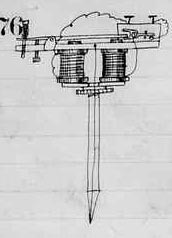
Pen made by Gilliland to Batchelor’s design
17 August 1875
[NE1676275] |
Batchelor’s Technical Notes and Drawings include an illustration of Edison’s design for the electric pen, dated 18 July [MBN001003]. By the 20th the prototype electric pen had been made [NE1676255], both drawings showing it to be remarkably close to its final form.
The entry in the Newark Shop Notebook for 20 July describes the new pen and the copying method, and is signed by Edison, Batchelor, James Adams, and Samuel Edison.
July 20th 1875 Copying Experiments
Have had a pen for pricking made to run with clockwork but found it no good so had one made to run by electric Engine & it was finished today. Proceeded to night to try it, it worked well but pricked too slow. The cam that moved the needle was made in this way. x
With writing slow we got along well but Wurth making a new cam like this † which he finished & then we went to work to get the press right for working.
We found that if we covered the roller of the press with cloth saturated with ink & rolled it over the copy it worked very good, also fastened the letter round the cloth covered roller worked well, also laying a flat piec[e of] saturated cloth over the [ ] the letter over it then taking a copy with the roller running over it was good. Also in the common copying press it worked well most any way. After this we found [it] wanted very little pressure & then a new idea dawned on us to take a printers roller with handle on it & cover [it with] saturated cloth. We also took a book & [cut] the cover out large enough to take a sheet of foolscap we then pasted our letter on the inside of cover shut up the book & rolled the roller in the outside. This was a perfect success & sample 1 was struck off this way with 100 others like it.
We tried all the other anilines with glycerine, olive oil, molasses, some pretty fair as original but not as good.
Printers ink & oil no good.
We tried to write letter on parchment but the ink went right through it seemed to combine.
Started Wurth on new [pen] to be made direct acting thus getting more power like drawing, the barrel also to be shorter so that the pen will be easier to h[old.]
We propose to make our press etc to consist of a cabinet with iron frame attached, to paste the letter to, the cabinet to have a cloth top.
A rubbing roller with handle.
1 Bottle (pint) of ink.
1 Camel hair brush & porcelain boat the last three to go inside of cabinet.
1 Cell of Grenet battery.
1 Pen & connections
1 [ ]
[NE1676255]
Note: The paper of these two notebook pages has been attacked by chemicals and parts of each page are missing. The lacking words are noted by [ ] above; logical interpolations are shown as [xxx].
In between other projects, development of the pen and press continued through August 1875. On the 2nd, a darker ink was made [NE1676259]; on the 6th a sketch of a “Copying Pen” was sent to John Ott [NM013S].
On 9 August 1875 Edison included “Electrical copying presses” in his list of “what we propose to put in the Centennial” i.e. the Philadelphia Centennial Exhibition, which was to run from 10 May through 16 December 1876 [LB001003].
On the 10th Edison wrote to Kidder & Co. to ask about licensing the manufacture of Kidder’s batteries:
We are using large quantities of Grenet batteries for an electric pen we are having made. We should prefer to use your Tip battery if we could make arrangements to make the parts ourselves & get the glasses from you in lots of (100) one hundred. [LB001004]
At some later date Batchelor recorded his own design for a pen, dated 13 August, on the same page of his Technical Notes and Drawings as Edison’s design of 18 July [MBN001003].
On the 16th further ink tests were described [NE1676277].
On 17 August 1875 the construction of the press was described and illustrated [NE1676275], and a new design of pen was ordered from Gilliland.
On 2 September 1875, as well as detailing improvements to the ink roller, Batchelor noted that:
Our new vibrator pen made by Gilliland is very good but it has kincks which deter it from going out to anybody but a man that understands a little about electricity. You could write much faster with it & it makes better copy but sometimes it will run for hours & then stop, as soon however you touch it or perhaps shake it runs off again.
Also improved the ink by adding molasses. [NE1674040]
Perhaps because of these “kincks”, Gilliland was not given the order to make the first pens, which went to John Ott, but on 3 September Edison placed an order with Gilliland for all the other components of the system:
You will please manufacture for me one hundred of the autograph presses, one hundred ink rollers for same, one hundred brushes, one hundred ink dishes, one hundred writing boards at the following prices
| Presses |
three dollars fifty cents |
($3.50) |
each |
| Rollers |
one dollar |
1.00 |
" |
| Brushes |
Thirty cents |
30¢ |
" |
| Ink Dishes |
|
10¢ |
|
| Writing boards |
|
25¢ |
|
Work to be Commenced at once, & rushed out. Presses to be Jappaned nicely, named & numbered, & ornamented. Pine board used in presses otherwise same as sample. [LB001013]
On 6 September 1875 John Ott was instructed by Batchelor to make the first run of electric pens:
You will proceed to make (100) one hundred electrical pens, the same as model to be delivered in (3) weeks as follows:-
Ten (10) the first week
Thirty (30) the second week
Sixty (60) the third week
to commence Sep 9th & for which we will pay you the sum of (1) one dollar each.
[LB001017]
This instruction was modified by Edison in a second note to Ott on the same day:
You will proceed to make (10) Ten pens same as model by hand to be delivered to the Laboratory by September 17th 1875 for which we will pay (4) four dollars each.
You will then proceed to make the necessary tools for manufacturing them for which we will pay (20) Twenty dollars the said tools to belong to us.
You will proceed to manufacture from these tools (100) one hundred pens equal to models made by hand & deliver to us as follows
(10) Ten on the 29th of September
(30) Thirty on the 6th of October
(60) Sixty on the 13th of October
We will pay for this hundred the sum of (1) dollar each.
[LB001018]
A marginal note by Batchelor on this document reads:
The first ten only taken.
Evidently none of the improved designs of the pen were put into production; it was Edison’s original design of 18 July that became the version first manufactured.
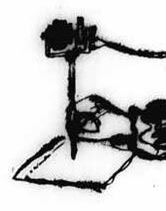
Sketch of the pen
from Batchelor’s
letter
to his brother
13 September 1875
[MBLB1018] |
In a letter to his brother Tom in Manchester, England, dated 13 September 1875, Charles Batchelor gives a detailed description of the pen and press then being made [MBLB1018]. The letter includes three sketches: the press and ink roller, a Grenet cell battery, and a pen of the July design with the flywheel in line with the pen’s shaft.
I write to give you a little better description of the press. We have sold agencies for 10 of the states and are hunting up reliable agents for the others. Our press consists of an electrical writing pen, an inking roller, a press, a battery, ink & brush.
Our pen is a small electrical engine with a holder about the size of a good thick pencil down which runs a needle which is made to perforate the paper as you write like sample & there is no difficulty in writing with it. The engine is run by a cell battery made in a nice shaped glass bottle & is an ornament to a man’s desk.
On 23 September 1875 Edison executed the first caveat for his electric-pen copying system:
| To all whom it may concern. Be it known that I, Thomas A. Edison of Newark in the county of Essex, and State of New Jersey, have invented an Improvement in Electro magnetic Paper-perforators for Autographic Writing' of which the following is a specification. |
| The object of this invention is to print a number of copies of a drawing or manuscript. The invention consists in forming a stencil by the perforation of holes in paper or other like material and metallic sheets, through which holes ink is made to pass and deposited upon the material underneath. |
| The invention further consists in the methods of preparing the stencil, by a vibrating point, held within a stylus deriving an up and down motion from a small clockwork upon such stylus, or by a small magnetic engine driven by a voltaic battery, the current from which is led to the engine by flexible conducting cords. |
| The invention further consists in the various devices which serve to give a proper vibratory motion to the perforating needle or point. |
| The invention further consists in the combination of various devices with the perforating stylus to obtain a number of impressions or copies. It further consists of a peculiar ink and of various modifications to make the process applicable to various purposes. |
| [First section of W100AAY] |

Sketches of the battery
from Batchelor’s notebook, 21 November 1875
[MBN002015] |
As development of the system continued, Edison and Batchelor encountered problems with the Grenet cell battery, and Batchelor described the resolution of this issue in a notebook entry dated 21 November 1875 [MBN002015]:
Autographic Press Battery.
We have experienced a great deal of trouble in the battery for running the pen for our autographic press. Up to Oct 14 1875 we have used the French small Grenet battery 2 cells to each pen. They are however very unsuitable for a man's desk & our experiments have at last terminated in one to our entire satisfaction. It is easily cleaned & comes all apart, it cannot tipp over, we use porous cells & the carbon & zinc can be lifted up.
The accompanying drawings show the new battery design, and this is the form that was used when full production began.
On 27 December 1875 Batchelor wrote to his brother to advise that he had sent him an electric pen outfit [MBLB1036]. The pen was hand-carried to Tom Batchelor by Edward Carnelly, whose family in Manchester was friendly with the Batchelors. Edward’s brother Thomas subsequently borrowed the pen from Tom Batchelor, and on 22 February 1876 he gave what is believed to be the first demonstration in the UK of the pen’s operation. In the report of his presentation to the Manchester Literary and Philosophical Society, Thomas Carnelly wrote:
"The instrument which I now wish to bring before the Society is an electric pen, quite recently invented by Thomas A. Edison, the great telegraphic engineer, of Newark, New Jersey, U.S. The instrument, which is the only one as yet in this country, was brought over by my brother, for Mr. T. Batchelor, to whom I am indebted for the loan of it this evening, and as it is an adaptation of electricity quite new and unique, and promises to be of great service, I thought that a description and exhibition of the same would be interesting to the Society."
There is much material to add on the development of the electric pen, but an examination of its commercial production proves interesting:
Electric Pen Production and Royalties
Once the pen went into regular production, Gilliland & Co. took over all the manufacturing, operating as Edison’s Electrical Pen & Duplicating Press Co. They had offices at 41 Dey Street in Manhattan and a factory in Menlo Park. This arrangement was in place from September 1875 until the end of 1876, a period of about 15 months, although for much of this period Edison was making sometimes extensive modifications to the pen and its battery. On 27 December 1876, Charles Batchelor, who was responsible for the duplicating business, wrote:
Up to this date we have sold (205) two hundred & five presses complete and quite some extras amounting to altogether to $3,880.28 for which we paid $2717 98/100 ...[D7607B1]
On 28 November 1876, Edison signed a contract to turn over the production of the pen and duplicating equipment to the Western Electric Manufacturing Company of Chicago [HM760024]. From early in 1877, Western Electric became responsible for all sales in the United States; the contract also called for the company to deliver complete outfits to Edison for foreign orders at $12.50 each. British orders were to be billed directly by W.E. at two pounds nine shillings and sixpence (at the then exchange rate of $5 to the pound this was also about $12.50 per unit).
In a letter to Edison dated 10 February 1877, George H. Bliss, Western Electric’s general agent in Chicago, who was responsible for promoting the electric pen in the United States and abroad, wrote:
“The Western Electric are rapidly increasing their capacity, which I hope for months to come, beginning with March 1-st, will be at least two hundred pens per month.” [D7711B].
There are no sales figures for Western Electric in the Edison Papers, but the entries for Western Electric/Electric Pen Royalties in Edison’s account books for the next several years tell a quite different story.
According to the Western Electric contract, royalties were payable to Edison and his partners at $5 per duplicating set and 15% on parts and supplies. An agreement with Charles Batchelor and James Adams of 2 October 1875 [D7504K] assigned $6.13 of each $10 of royalties to Edison (plus a further $1.15 to the Laboratory), or approximately $3 due to Edison (not including the amount to the Laboratory) out of the $5 paid by W.E. on each outfit.
The royalty descriptions and amounts shown in the table below have been transcribed from Edison’s ledgers; unit sales are estimated using $3 royalty per unit. As the ratio of outfits to parts sales is unknown, the calculation also allocates the full amount of the royalties to sales of complete outfits; the estimate of the number of units thus errs on the high side.
| Description |
Royalties |
Units |
| |
| Edison sales prior to Western Electric contract [D7607B1] |
| 1875-76 |
Unit sales to date as of 27 December 1876, per Charles Batchelor |
|
205 |
| |
| Western Electric Mfg Co, Sheet 88 [A200A, image 46] |
| 1877 |
| Mch 1st |
Royalties due on Electric pen |
$613.40 |
|
| Apl 30 |
Royalty due in Mch & Apl |
630.45 |
|
| |
Royalty for May |
761.09 |
|
| Aug 13 |
Royalty, June & July |
593.80 |
|
| Nov 14 |
Royalty Aug Sept & Oct |
646.80 |
|
| Feby 4 [1878] |
Royalty for Nov & Dec |
533.72 |
|
| Total Royalties for 1877 |
$3,779.56 |
1260 |
| 1878 |
| Feb 12 |
Royalty for Jan 1878 |
$190.70 |
|
| Feb 28 |
Royalty for Feb 1878 |
302.71 |
|
| Apr 1 |
Royalty for March |
216.91 |
|
| May 20 |
Royalty for Apr |
237.83 |
|
| June 1 |
To Elec P.R. May |
196.10 |
|
| 1 |
" " " June
|
215.11 |
|
| Aug 1 |
" " " July
|
106.37 |
|
| Sep 1 |
" " " Aug
|
184.87 |
|
| Nov 1 |
" " " Sep
|
381.29 |
|
| Total Royalties for 1878 |
$2,031.89 |
677 |
| These royalties for 1878 are also shown on another ledger page titled Home Electric Pen (Royalty), Sheet 131 [A200A, image 63] |
| |
| Foreign pen royalties on sales made from the US: 1 September 1877 through 30 September 1878, per letter from George Bliss dated 17 December 1878 [D7822ZCP1] |
| 1877-78 |
|
Outfits, parts and supplies (units is actual count: 78 outfits and 2 pens).
Royalties paid at $3 per outfit, 15% on parts and supplies. |
$242.49 |
80 |
| |
| Foreign pen royalties on sales in Europe reported by Beetle: 1 September 1877 through 12 August 1878, per letter from George Bliss dated 2 January 1879 [D7923A1 and D7923A2; see also Beetle ledger at D7822ZBK]. |
| 1877-78 |
|
Outfits, parts and supplies (units is actual count).
Royalties paid at $3 per outfit, 15% on parts and supplies. |
$544.25 |
169 |
| |
| Electric Pen Royalty, Sheet 283 [AB001, image 125] |
1879 |
Nov 30 [1878] |
W E M Co |
$139.45 |
|
Jan 10 |
W E M Co |
291.34 |
|
Feb 1 |
W E M Co |
221.91 |
|
Mar 22 |
W E M Co |
95.79 |
|
Apr 1 |
By W E M Co Feb Mar |
176.02 |
|
| July 1 |
" " " Apr May June |
438.48 |
|
| Oct 1 |
" " " July Aug Sep |
159.65 |
|
| Nov 1 |
" " " Oct |
102.60 |
|
| Total Royalties for 1879 |
$1,725.20 |
575 |
| |
| Foreign Electric Pen Roy, Sheet 285 [AB001, image 126] |
1879 |
July 1 |
By Geo H Bliss |
$466.52 |
155 |
| |
| Electric Pen Roy, Sheet 55 [AB005 image 21] |
| 1880 |
Jun 1 |
By W E Co |
$25.28 |
|
1 |
" " " |
54.71 |
|
1 |
" " " |
43.10 |
|
Aug 1 |
W E M Co |
58.73 |
|
Sep 17 |
By W E M Co |
34.38 |
|
Nov 1 |
By W E M |
31.78 |
|
Jan 1 [1881] |
By W E M |
57.45 |
|
Total Royalties for 1880 |
$305.43 |
101 |
| |
| Western Electr : Electric Pen, Sheet 3 [AB006 image 15] |
| 1881 |
| Apl 5 |
By Cash W.E. |
$92.73 |
|
| June 18 |
" "
|
38.00 |
|
| Aug 11 |
" "
|
15.65 |
|
| Nov 11 |
" "
|
30.98 |
|
| Total Royalties for 1881 |
$177.36 |
59 |
| |
Letter from Western Electric dated 29 May 1884 [D8463A]
Royalty paid Thos A. Edison on Electric Pen Sales from Feby 1st 1882 to Aug 31st 1883 |
| 1882-83 |
| April 21st 82 |
|
$27.77 |
|
| May 8th " |
|
46.43 |
|
| Oct 21st " |
|
134.45 |
|
| " " " |
|
92.96 |
|
| Nov 9th 83 |
|
96.40 |
|
| Total Royalties 1882-83 |
$398.01 |
132 |
| Note: Royalties recorded in Edison’s ledger book for this period (Edison Electric Pen Royalty, Sheet 212 [AB004 image 90]) confirm the Western Electric numbers for April 1882 through November 1883, and show an additional payment of $7.03 for February 1882. This ledger page also records royalties for 1884 and 1886; see details below. |
| |
| 1883-84 |
Sep 1, 1883
through
Mar 31, 1884 |
Total sales $2,137.79 (units calculated assuming a wholesale price of $12.50 per outfit) |
|
170 |
| |
| Edison Electric Pen Royalty, Sheet 212 [AB004 image 90] |
| 1884 |
| Oct 24 |
By Western Electric Co. |
$175.21 |
|
| Dec 16 |
" Cash |
86.32 |
|
| Total Royalties for 1884 |
$261.53 |
87 |
| |
| Edison Electric Pen Royalty, Sheet 212 [AB004 image 90] |
| 1886 |
| Apr 27 |
By Cash |
$129.61 |
|
| Total Royalties for 1886 |
$129.61 |
43 |
| |
| Electric Pen Royalty, Sheet 251 [NL012A1 image 122] |
| 1890 |
| June 1 |
By Sundries |
$333.44 |
|
| 1891 |
| Jan 6 |
Accts Receivable |
45.12 |
|
| 1892 |
| Jan 16 |
" "
|
40.49 |
|
| Dec 1 |
" "
|
21.39 |
|
| 1894 |
| Jan 1 |
By Accts Receivable |
6.63 |
|
| |
| Total Royalties 1890-1894 |
$447.07 |
149 |
| |
| Total documented unit sales (estimated) |
|
3,850 |
The peak sales of the pen and duplicating press were in the first three years of commercial production by Western Electric, but it appears that no more than 2,500 outfits were sold in the United States between February 1877 and November 1879. Statements from George Bliss show 249 units from foreign sales for 1877-78, and the 1879 ledger has a page titled "Foreign Electric Pen Royalties" with an entry for $466.52, representing perhaps an additional 155 pens in that year. It’s likely that there were also foreign royalties in other years, but details of these are not recorded in the documents currently accessible in the Edison Papers.
In 1878 Bliss issued a prospectus (produced by electric pen) for "The Edison Merchandising Co.", the purpose of which was to "acquire control of ... the Electric Pen business" [D7822ZBD]. In this document he claimed that "Upwards of
5000 Electric Pens have been sold in the United States and about the same number scattered through all the Commercial Countries of the World", but based on the royalty numbers shown above, this was obviously puffery. The intent of the new company was to raise $500,000, with 10% paid in, and much of this capital would presumably have gone to Western Electric.
By 1880 Edison’s electric pen business was in decline, as a number of mechanical pens of much simpler construction (and lower price) had come on the market.
On 17 January 1880 Edison wrote a letter to Western Electric agreeing to reduce his royalty to 12% of the selling price to the customer for one year. [X012L1F]
A letter from Bliss to Edison dated 7 April 1880 summarized the European situation:
T.A. Edison Esq.
Menlo Park, N.J.
Dear Sir:
Do you think there is any use in keeping up the patent annuity on the Electric Pen in Europe?
There is no protection and no business being done.
Cant you see some way to make the Pen pan out in Europe.
Geo. H Bliss
[D8027B]
|
Then on 3 May 1880, Edward Hibberd Johnson of The Edison Telephone Company of London Limited, wrote to Edison:
| London May 3rd 1880 |
| My Dear Edison |
No, the day for the Electric Pen has passed - Had it been launched in a better manner it could have held its own - but there are now a multitude of new devices for transferring letters ad lib. many of them very simple & effective - & cheap. It is too late to make any headway with the E.P. against a field borne of its own seed.
Your Truly,
E.H. Johnson
[D8027D]
The royalty statements for 1880 and 1881 show a total of only $482.79, representing an estimated 160 outfits sold.
The next reference in the Papers to electric pen sales and royalties is a letter from Western Electric dated May 29, 1884, responding to a request made on January 25th for a statement of royalties paid during the last two years [D8463A]. This letter reported royalties on sales from 1 February 1882 through 31 August 1883, and sales from 1 September 1883 through 31 March 1884, on which royalties had presumably not yet been paid. Based on these figures, the total number of outfits sold in that 26-month period may well have been no more than 300 (again not accounting for possible foreign sales).
After the 1884 letter there are no further royalty statements in the Papers until much later. The 1888-1890 West Orange ledger shows no pen royalties, and the final royalty entries are in the 1890-94 ledger. Royalties for those years are all summarized on one ledger page and represent no more than 149 units for the entire period [NL012A1 image 122].
By 1887 Edison had licensed his copying patents to A.B. Dick, who coined the name “Mimeograph" for his stencil duplicating system, retaining Edison’s name as a marketing device. It was far easier to cut stencils for the mimeograph using a wheel pen or a typewriter, and the electric pen, while continuing to be sold and used into the 1890s, was essentially obsolete ten years after its introduction. It is interesting to note that in the 1890-94 period, when electric pen royalties were just $447.07, Edison received over $7,000 in royalties and dividends for the mimeograph from A.B. Dick [NL012A1 image 122].
In 1933, forty years after the electric pen became obsolete, Edison’s associate Francis Jehl wrote a letter to AB Dick in which he said, “The electric pen was a Godsend to business in many ways and more than sixty thousand Edison outfits were made.” However, while Jehl had used an electric pen at his previous employer, when he went to work for Edison in 1879 he was involved mainly with the electric light and electrical generation, and it seems likely that he was quoting the hyperbole of some of the electric pen advertising material of the time rather than having direct knowledge of the production and distribution of the pen.
Further, no electric pen has been found with a serial number higher than 8739, and the analysis above of known royalty statements indicates a production rate far lower than the many thousands per year which would have been needed for a total production of 60,000. Unit sales calculated from the recorded sales and royalties represent no more than an estimated 3,300 pens, most of them in the years 1876 through 1879.
In 1881, after which the royalty records indicate that only a few hundred more pens were sold, a series of Western Electric advertisements ran in Science from February through July of that year. These advertisements only claimed “10,000 Pens now in Use,” and this number itself was almost certainly inflated, given that pen sales were rapidly declining rather than “Steadily Increasing”.
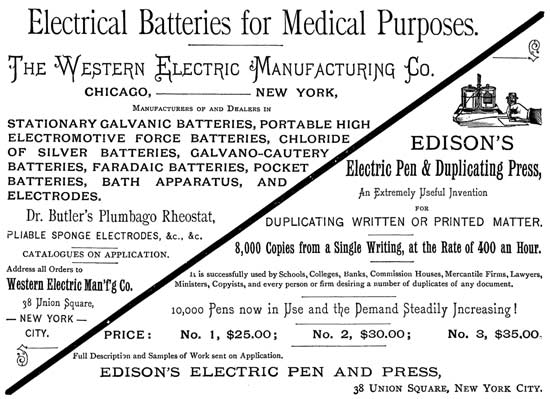
Western Electric Advertisement
Science Vol. 2 No. 33 (Feb. 12, 1881) |
Even allowing for royalty payments and foreign sales not recorded in the Edison Papers archive, it is likely that fewer than 10,000 pens were ever produced. |

